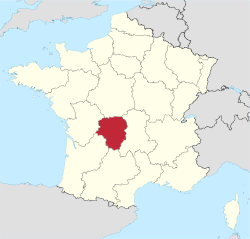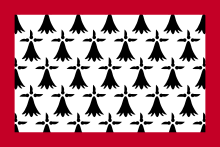Limousin
Coordinates: 45°41′17″N 1°37′14″E / 45.68795°N 1.620483°E
| Limousin | |||
|---|---|---|---|
| Region of France | |||
| |||
 | |||
| Country |
| ||
| Prefecture | Limoges | ||
| Departments | |||
| Government | |||
| • President | Gérard Vandenbroucke (PS) | ||
| AreaINSEE | |||
| • Total | 16,942 km2 (6,541 sq mi) | ||
| Population (2010-01-01) | |||
| • Total | 742,771 | ||
| Time zone | CET (UTC+1) | ||
| • Summer (DST) | CEST (UTC+2) | ||
| ISO 3166 code | FR-L | ||
| GDP (2012)[1] | Ranked 21st | ||
| Total | €17.3 billion (US$24.2 bn) | ||
| Per capita | €24,354 (US$34,076) | ||
| NUTS Region | FR6 | ||
| Website | (French)cr-limousin.fr | ||
Limousin (French pronunciation: [limuzɛ̃]; Occitan: Lemosin) is one of the 27 regions of France. It is composed of three departments: Corrèze, Creuse and Haute-Vienne.
Situated largely in the Massif Central, as of January 1, 2010, the Limousin had 742,771 inhabitants on nearly 17,000 km2, making it the second-least populated region of France after Corsica.
Forming part of the southwest of France, Limousin is bordered by the regions of Centre to the north, Poitou-Charentes and Aquitaine to the west, Midi-Pyrénées to the south and Auvergne to the east. Limousin is also part of Occitania.
Formation
The modern region of Limousin is essentially composed of two historical French provinces:
- Limousin: the department of Corrèze in its entirety and the central and southeastern part of Haute-Vienne. The entire old province of Limousin is contained within the modern Limousin.
- Marche: most of the department of Creuse and the north of Haute-Vienne. The old province of Marche is almost entirely contained within the modern region of Limousin, with only a small part of Marche now belonging to the region of Centre.
Beside these two main provinces, Limousin is also composed of small parts of other former provinces:
- Angoumois: extreme south-west of Haute-Vienne
- Poitou: extreme west of Haute-Vienne
- Auvergne: extreme east of Creuse
- Berry: extreme north of Creuse
Today the province of Limousin is the most populous part of the Limousin region. Limoges, the historical capital and largest city of the province of Limousin, is the capital of the Limousin administrative region.
Population
With a slowly rising population of just under 750,000, Limousin is the second-least populous region in Metropolitan France after Corsica.
The population of Limousin is aging and, until 1999, was declining. The department of Creuse has the oldest population of any in France. Between 1999 and 2004 the population of Limousin increased slightly, reversing a decline for the first time in decades.[2]
Major communities
Economy
Limousin is an essentially rural region. Famed for some of the best beef farming in the world, herds of Limousin cattle—a distinctive chestnut red—are a common sight in the region. The region is also a major timber producing area.
Due to its rural locality, it is also famed for its groves of French Oak, so prized for its distinct characters and flavors in wine fermentation that vintner Rémy Martin has exclusive rights to its oak groves. It is a partnership that is over 100 years old.
The regional capital, Limoges, was once an industrial power base, world-renowned for its porcelain and still a leader and innovator in electric equipment factories (which originally used porcelain as an insulator). However, large factories are now few in number.
Geography and climate
Bodies of water
Some of the rivers belonging to the Loire basin run through the north, west and east of the region, waterways belonging to that of the Dordogne through the south. The region is crossed by three major rivers: the Vienne, the Dordogne and the Charente (which has its source in Haute-Vienne). The region is well known for the high quality of its water and for offering first-rate fishing.

Topography
The Limousin region is almost entirely an upland area. The lowest land is in the northwest of the region (approximately 250 m above sea level) and the highest land is roughly in the southeast (approximately 1000 m above sea level). However, the greater part of the region is above 350 m.
Climate
Although summer temperatures often exceed 30 °C – and have even reached as high as 42 °C – the Limousin region has a damper and milder climate than neighbouring regions. Winters are often long and cold, especially in the higher areas, and snow is not at all uncommon.
Shepherds working in Limousin needed protection from the cool damp winters and traditionally wore a cloak with a large hood.[3] which lent its name to the Limousine in which early drivers wore a similar protective cape. Despite that, the area around Brive in the Corrèze has more than 2000 hours per year of sunshine, the same as the southern city of Toulouse.
History

Limousin is one of the traditional provinces of France. Its name is derived from the name of a Celtic tribe, the Lemovices.
Aimar V of Limoges was a notable ruler of the region.
Culture

Until the 1970s, Occitan was the primary language of rural areas. There remain several different Occitan dialects in use in Limousin, although their use is rapidly declining. These are:
- Limousin (Occitan: Lemosin) dialect
- Auvergnat (Occitan: Auvernhat) dialect in the East/North-East
- Languedocien (Occitan: Lengadocian) in the Southern fringe of Corrèze
- in the North, the Crescent transition area between Occitan and French is sometimes considered as a separate (basically Occitan) dialect called Marchois (Occitan: Marchés).
Perhaps due to its rural character, Limousin has maintained a strong tradition of traditional music, with ancient instruments such as the bagpipe (called chabrette, Chabreta in occitan) and hurdy-gurdy remaining popular.
Gastronomy
Pâté aux pommes de terre is one of the specialties of Limousin, as well as of the neighbouring department of Allier. Clafoutis is a local dessert.
Music
- Festival 1001 Notes, music festival in Haute-Vienne, August
- Festival de La Vezere, music festival in Corrèze July–August
- Festival du Haut Limousin, music festival in Haute-Vienne, July–August
- La Borie en Limousin, foundation of music in Haute-Vienne
Notables
From Corrèze
- Étienne Aubert (1282-1362) : Pope Innocent VI
- Étienne Baluze (1630-1718) : scholar
- Marshal Guillaume Brune (1763-1815) :General of the Revolution, Marshal of the Empire
- Jean Cazeneuve (1915-2005) : philosopher and sociologist, president of the ORTF and of TF1
- Bernadette Chirac : First lady between 1995 and 2007.
- Jacques Chirac : President of the French Republic (1995-2007)
- Marcel Conche : philosopher, teacher at the Sorbonne
- Jacques Delors : minister, president of the European commission
- Cardinal Guillaume Dubois (1656-1723) : Prime Minister
- Thomas Domingo : rugby player
- Léon Eyrolles (1861-1945) : entrepreneur and politician
- Antoinette Feuerwerker (1912-2003): lawyer and resistant
- David Feuerwerker (1912-1980): Rabbi and resistant
- Eugène Freyssinet (1879-1962) : inventor of prestressed concrete
- Cédric Heymans : rugby player
- François Hollande : President of the French Republic (2012- )
- Laurent Koscielny : football player in Arsenal FC
- Pierre André Latreille (1762-1833) : entomologist
- André Malraux (1901-1976) : writer, resistant and minister
- Jean-François Marmontel, historian
- Edmond Michelet (1889-1970) : resistant and minister
- Marie-Anne Montchamp : secretary of State
- Robert Nivelle (1858-1924) : general during the World War I
- Edmond Perrier (1844-1921) : anatomist and zoologist
- Henri Queuille (1884-1970) : minister and Prime Minister (1948-1949, 1949-1950, 1950-1950, 1951-1951)
- Pierre Roger (1291-1352) : Pope Clement VI
- Pierre Roger de Beaufort (1329-1378) : Pope Gregory XI
- Éric Rohmer (1920-2010) : director
- René Teulade : minister
- Denis Tillinac : writer
- Jean-Baptiste Treilhard (1742-1810) : lawyer and revolutionary
- Marius Vazeilles (1881-1973) : politician and archeologist
- Bernard de Ventadour (1125-1195) : troubadour
- Cédric Villani : mathematician, Fields medal
- Pierre Villepreux : rugby player
- Rose Warfman (1916) : resistant
- Dimitri Yachvili : rugby player
From Creuse
- Thierry Ardisson : host and journalist
- Pierre d'Aubusson : Great Master of the Sovereign Military Order of Malta
- Jacques Barraband : painter and draftsman
- Jean de Brosse : Marshal
- Gilles Clément : landscape designer
- François Denhaut : inventor of flying boats
- Léonard-Léopold Forgemol de Bostquénard : General
- Armand Guillaumin : painter
- Jean Guitton : philosopher and writer
- Marcel Jouhandeau : writer
- Lucien Le Cam : statistician
- Pierre Leroux : philosopher and politician
- Jean Lurçat : artist
- Jules Marouzeau : Latinist
- Pierre Michon : writer
- Claude Monet : painter
- Martin Nadaud : politician and writer
- Raymond Poulidor : cyclist
- Claude Ribbe : writer, philosopher and director
- Maurice Rollinat : poet
- Jules Sandeau : writer
- Georges Sarre : Secretary of State
- Antoine Varillas : historian
- Hubert Védrine : Minister of Foreign Affairs
From Haute-Vienne
- Geoff Bunn : British artist
- Jean Giraudoux : novelist and diplomat.
- Joseph Louis Gay-Lussac : chemist and physicist
- Paul Rebeyrolle : artist
- Pierre-Auguste Renoir : painter
- Pierre Desproges : humorist
See also
- TER Limousin
- Limousin (dialect), the Occitan dialect of the region.
- Limousin (cattle), a breed of beef cattle bred in the Limousin region and recognisable by their chestnut red coloring.
Footnotes
- ↑ INSEE. "Produits intérieurs bruts régionaux et valeurs ajoutées régionales de 1990 à 2012". Retrieved 2014-03-04.
- ↑ Yann Leurs, Recensement : rebond démographique confirmé, INSEE, 2006, see online
- ↑ "History of the Limousine". Lancashirelimos.co.uk. Retrieved 2010-04-16.
External links
- Limousin : the “château d'eau” - Official French website (in English)
- (French) Limousin regional council website, with a presentation video in English.
- (French) Art in the Limousin region
- (French) History and Geography (University of Limoges)
| ||||||||
